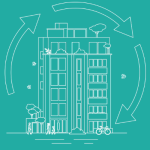Meet G&T Partner, Yiannis Proestos.
With seven years at Gardiner & Theobald under his belt, Yiannis manages a range of projects from high-end owner occupier schemes, multi-unit developments, hotel projects, F&B fit-outs and everything in between.
No two days are the same.
Monday – managing the unexpected
Mondays always bring fresh challenges. On my commute into London, I map out my priorities, but plans don’t always go as expected. A site visit to a new apartment fit-out project, scheduled for this morning, is pushed back due to transport issues, requiring quick coordination with the team and client to reschedule. The project is two months away from finishing, so keen to check on progress.
While travelling, I work through my inbox, reviewing a planning submission pack for a major hotel refurbishment in the West End and tracking outstanding tasks. Over time, I’ve structured my approach, relying on trackers and lists to keep everything clear and organised.
Tuesday – driving progress
With Monday’s reshuffles behind me, I make it to the fit-out site. Spotting some minor delays in the finished installation, I check in with the contractor to understand their recovery plan. The client is relying on the works completing on time, with tenants due to move in shortly. The contractor hasn’t quite worked out the recovery plan yet, but we agree to catch up tomorrow to talk it through.
The team is now finalising the planning submission for the hotel, a refurbishment of a historic Georgian building which is due to be submitted this week. With stakeholder input, only a few tweaks are now needed and we remain on course. Keeping clients informed ensures setbacks are managed efficiently, and expectations remain realistic.
Wednesday – problem-solving and teamwork
The day starts with a constructive chat over coffee with the fit-out contractor to uncover the reasons behind their delays, allowing us to collaborate on a recovery plan to move forward.
Meanwhile, client feedback on the planning submission lands with comments requiring some late-stage design considerations around facade articulation, and rooftop plant screening. These need broader input from the architect and engineer on the project, so I arrange a meeting to bring all perspectives together so we can move forward as a team.
Thursday – client collaboration
An early call with the project architect provides clarity on the revisions needed for the planning submission, which determines what’s achievable within the timeframe.
Later on, we meet with the client to brief them on options. Balancing ambition with feasibility, we put forward a plan to enable a submission to be made on time which we understand is the client’s main objective. The team can’t incorporate all comments in the time available so a decision from the client is required on how to proceed. Managing stakeholder expectations is part of my role and means having difficult conversations but they’re essential to keep things moving.
Friday – strategy and reflection
We’re nearly at the point of submission – but a curveball arrives. The client has decided a more detailed feasibility study is needed and that this is their priority. Staying calm, I regroup with the team to assess potential next steps.
Collaboration is a constant whether through meetings or catchups over coffee / lunch. Project success isn’t just about hitting deadlines — it’s about building and maintaining strong relationships.
As the week wraps up, I reflect on the progress made, lessons learned and priorities for the coming days. Despite a few challenges, adaptability and clear communication remain key to managing expectations and projects moving forward.
If Yiannis’ week sounds like your kind of challenge, why not consider a career in our industry? Whether you’re drawn to problem-solving, collaboration or seeing projects come to life, there’s plenty of opportunity to grow and make an impact.


